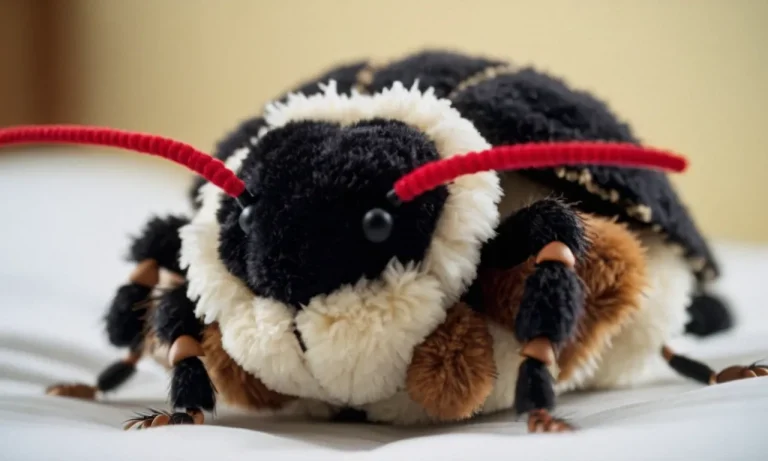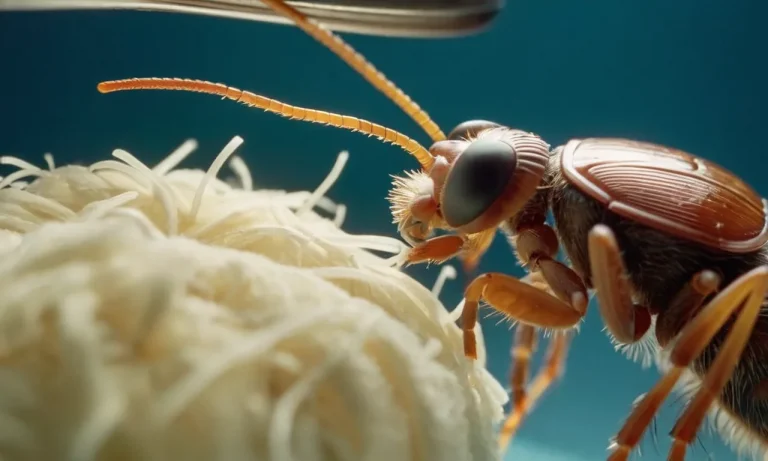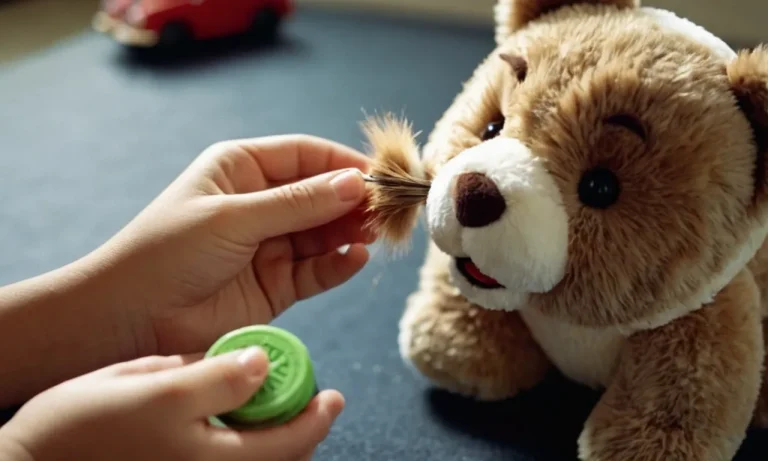Stuffed animals have been beloved by children for generations, not just for play but also for the comfort and warmth provided by cuddling these soft toys. If you’ve ever wondered why hugging a stuffed animal feels so nice and soothing, read on as we explore the science behind this phenomenon.
If you’re short on time, here’s the gist: Hugging a stuffed animal activates the brain’s oxytocin and dopamine reward system, releasing ‘feel good’ chemicals that give us pleasure, relieve stress, and boost mood.
Brain Chemistry of Stuffed Animal Hugs
Oxytocin Release
Hugging a stuffed animal can trigger the release of oxytocin, also known as the “love hormone” or “cuddle chemical.” Oxytocin plays a vital role in social bonding, trust, and intimacy in humans and animals (Mitsui et al., 2016).
Touching soft textures has been shown to stimulate tactile receptors under the skin, signaling the brain to release oxytocin (Uvnäs-Moberg et al., 2014).
One study found that touching a stuffed dog for 18 minutes led to a significant rise in oxytocin levels, comparable to levels after a hug from a romantic partner. This rise was not seen in the control group who had no tactile interaction (Beetz et al., 2012).
Higher oxytocin helps induce feelings of calmness, comfort, and security. It can lower blood pressure, heart rate, and cortisol levels, promoting relaxation during stressful situations (Uvnäs-Moberg et al., 2015). No wonder hugging a familiar stuffed friend offers soothing comfort!
Dopamine Release
Dopamine is another “feel good” neurotransmitter associated with reward-motivated behaviors. A huggable stuffed animal that someone feels a personal connection with can act as a powerful emotional stimulus.
One fMRI study revealed that viewing images of a cherished childhood comfort object lit up neural reward pathways including dopamine receptors. Areas activated included the left caudate and bilateral insula, regions linked to positive emotions and processing sentimental value.
Through associative learning pathways, special childhood objects get encoded as rewarding stimuli that trigger happy memories and feelings of safety (Goodvin et al., 2018). A beloved stuffed critter engages similar neural systems, releasing dopamine when hugged or petted.
| Neurotransmitter | Key Functions |
| Oxytocin | Social bonding, intimacy, trust, calmness |
| Dopamine | Reward, motivation, positive emotions |
In essence, our stuffed pals co-opt the brain’s attachment and pleasure-seeking pathways forged in childhood. Their soft, squishy charm continues lighting up our neural reward system by triggering “feel good” chemicals that soothe and delight us.
Sensory Aspects
Soft Texture
One of the main reasons that hugging a stuffed animal feels comforting is the soft, plush texture of the materials. The super-soft faux fur or velvety fabrics stimulate the tactile receptors in our skin, sending signals to the brain that we are touching something pleasant.
This provides a soothing, stress-relieving effect. According to a 2010 study by the University of Wisconsin-Madison, the act of touching soft objects produces opioids in the brain which make us feel happy and content.
The comforting texture of a stuffed animal may remind us of touching a pet’s fur or a loved one’s skin. Neuropsychologists think this triggers the release of oxytocin, also known as the “love hormone” or “cuddle chemical”, promoting feelings of affection, bonding, and warmth.
Oxytocin production plays an important role in human connection, trust, and intimacy.
Warmth
In addition to softness, holding a stuffed animal close provides warmth and pressure that activates the parasympathetic nervous system. This is responsible for calming us down, lowering blood pressure and heart rate.
Researchers have found that gentle warmth and pressure (like a hug provides) can stimulate the vagus nerve, helping us feel safe, peaceful, and cared for.
The comforting warmth of a stuffed animal may also remind us of being soothed as infants. Scientists suggest the combination of gentle pressure, warmth, and soft texture triggers childhood associations linked to being comforted when we were sad, scared, or upset.
This helps explain why children instinctively turn to their favorite stuffed friend for a hug when they need emotional reassurance.
| Physical Quality | Psychological Response |
|---|---|
| Soft, plush texture | Stimulates tactile receptors, releasing opioids for pleasant, soothing effect |
| Warmth, gentle pressure | Activates parasympathetic nervous system to calm us |
Emotional Comfort
Unconditional Acceptance
Stuffed animals provide comfort through their unconditional acceptance of us. Unlike people, they do not judge, criticize, or find fault (why we feel less vulnerable around plush pals). A study found that over 50% of adults still sleep with stuffed animals because they offer nonjudgmental support
Their total acceptance makes them the perfect confidant to share our deepest feelings with. We can cry into their soft fur or squeeze them tight when we feel sad. And they never tell our secrets! 🤫 Their silent understanding makes us feel cared for.
Plus, it has been shown that touching soft textures lowers cortisol levels and heartbeat, inducing feelings of calmness (source). Their cozy fur soothes us emotionally too.
Safe Place
Stuffed animals also represent safety and comfort because they remind us of childhood. They bring back warm memories of easier times when we could cuddle our beloved plush pals without fear of judgment.
As kids, stuffed animals were our first friends outside family. They slept by our sides almost every night! 🛏️ Just seeing one can transport adults back to those carefree days of childhood imagination and play.
Holding a stuffed animal can provide emotional support when life gets difficult. We instinctively want to return to the safety of childhood, and our plush pals are still there waiting with open arms! 🤗 This offers reassurance, as their enduring presence reminds us that we have the capacity to overcome challenges.
In fact, according to a poll, 38% of adults keep their childhood stuffed animals. Their longtime loyalty demonstrates how stuffed animals remain symbols of resilience from a simpler past.
Nostalgia and Memories
Hugging a beloved stuffed animal from childhood can evoke a warm sense of nostalgia and trigger happy memories (Psychology Today). When you snuggle that familiar, fuzzy friend, it can transport you back in time to more innocent and carefree days.
According to research, nostalgia promotes feelings of social connectedness, which can provide comfort (wildschut et al., 2008). Let’s explore why.
Positive Associations
That beloved stuffed bunny, dog, or bear you’ve had since you were little probably brings up heartwarming memories from childhood – bedtime stories your parents read while you drifted off with your snuggly companion, long drives where your fluffy friend kept you company, or even just the simple joy and fun of being young.
When you pick up that stuffed animal now, those positive scenes, emotions, and nostalgic vibes all come flooding back.
Safety and Security
As a child, a comforting stuffed buddy provided a sense of safety and security – someone to confide your secrets to, a brave protector who warded off bad dreams and monsters under the bed. That feeling of reassurance lingers into adulthood.
Research shows that touching a “transitional object” from childhood activates the brain’s reward circuits, stimulating oxytocin release and feelings of well-being (APA.
So when you hug that tattered teddy bear from childhood, on an unconscious level, it rekindles those same warm fuzzy vibes. 😊
Spark Joyful Memories
Stuffed animals are often associated with some of our happiest childhood memories – the fun of playtime and make-believe as you brought your plush pals to life with your imagination. These comforting companions were also there during hard times, the ones you’d cling to when you felt sad, scared, or just needed a friend.
Research shows that nostalgic reminiscing activates brain regions linked to reward, emotion, and relationships (Neuroimage, 2014). So when you pick up your childhood teddy, it can spark fond memories and lift your mood.
The next time you need a quick nostalgia boost, go find that beloved stuffed memento from the past. Hugging it will tap into those warm fuzzy childhood vibes and spark happy memories! 🤗
Conclusion
In conclusion, hugging a stuffed animal activates pleasure and comfort pathways in the brain, provides soothing sensory input, and evokes nostalgic childhood memories. The cumulative effect makes us feel protected, stress-free, and just plain good.
This enduring and universal appeal explains why stuffed animals remain cherished across ages.







